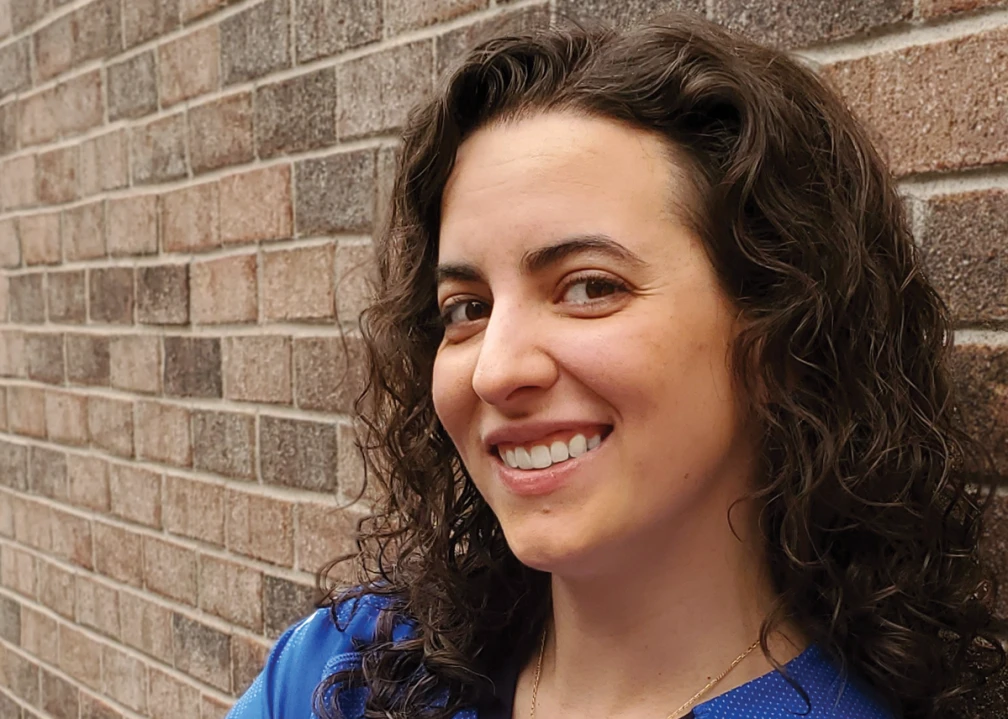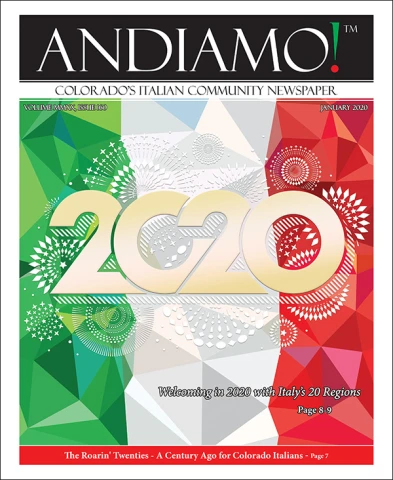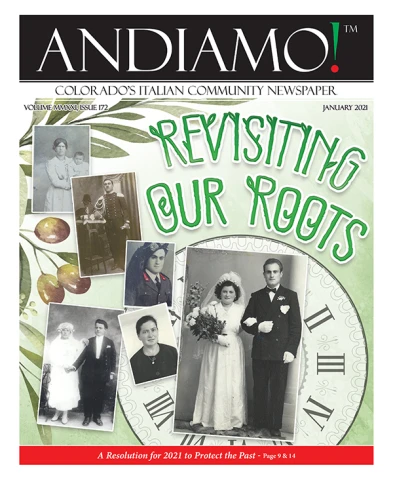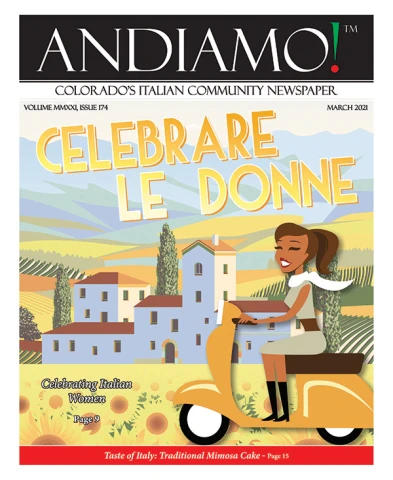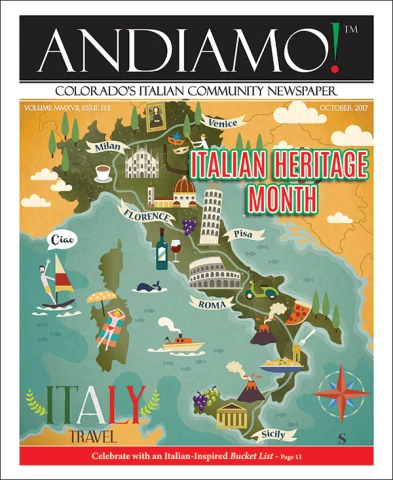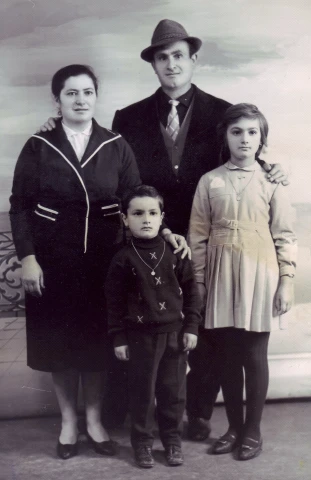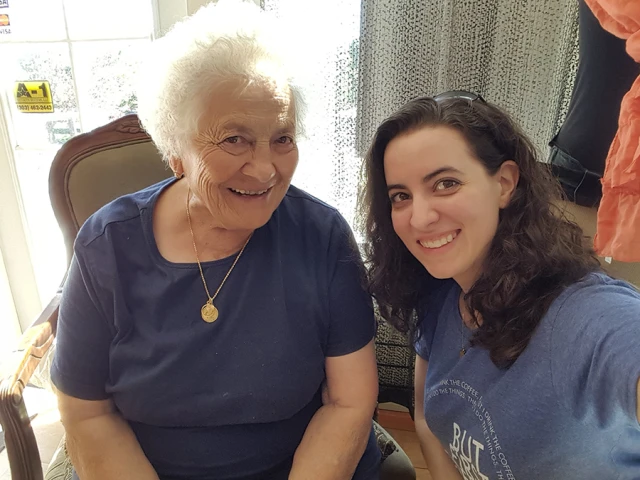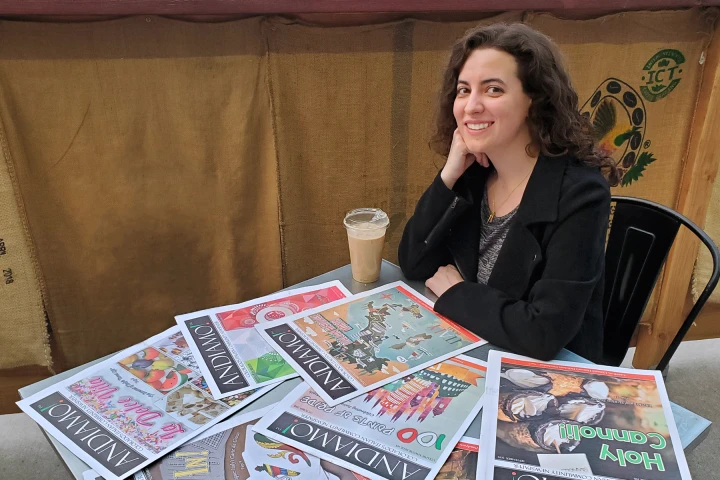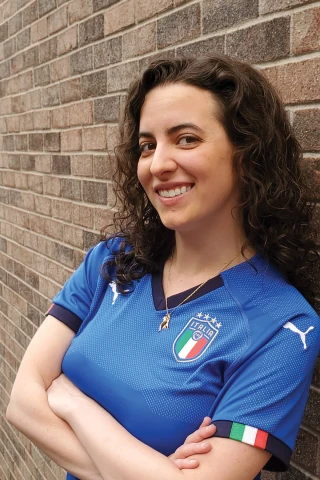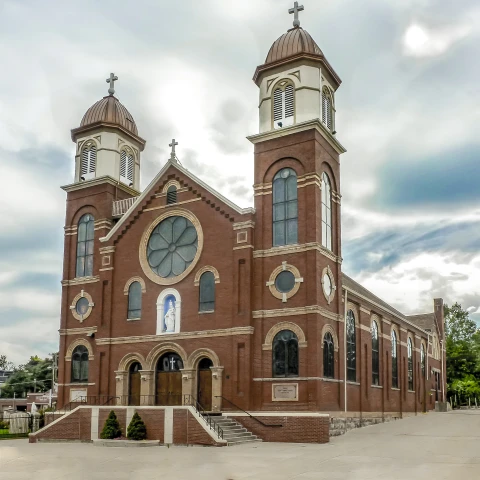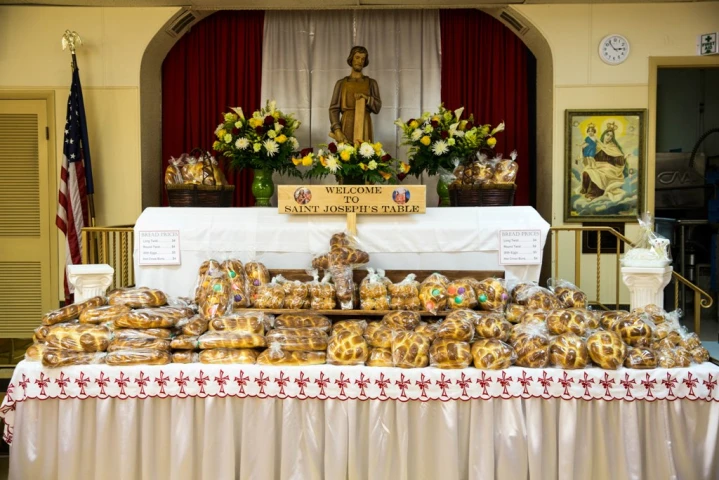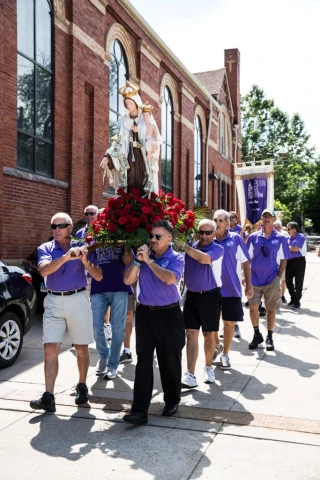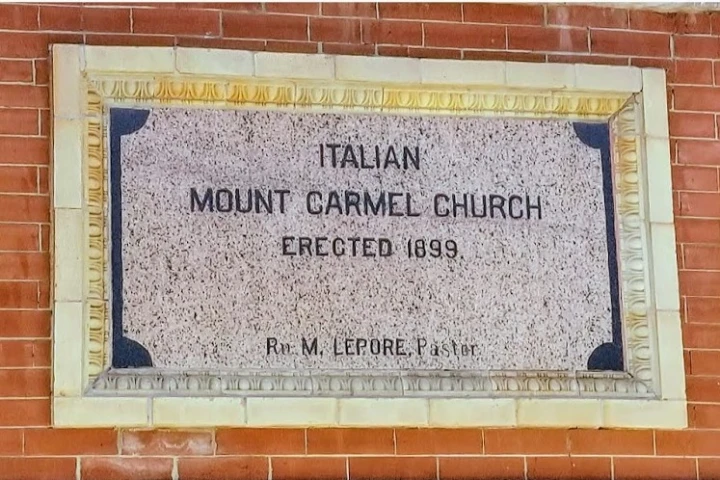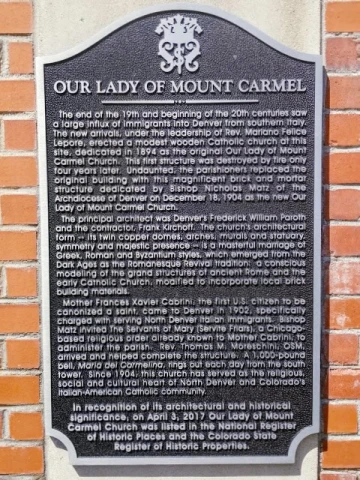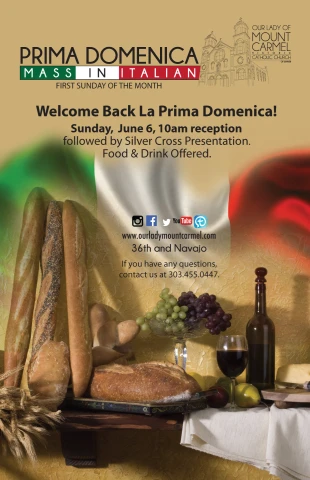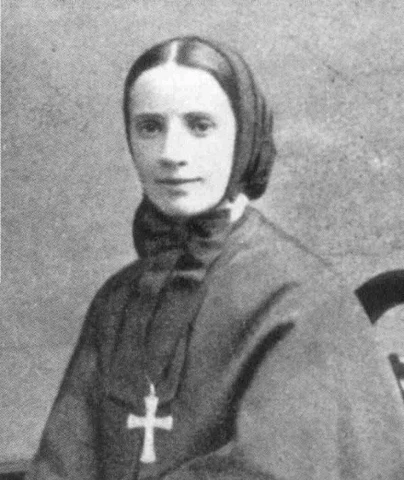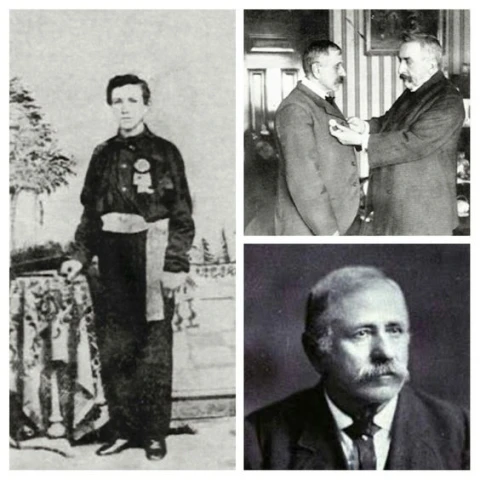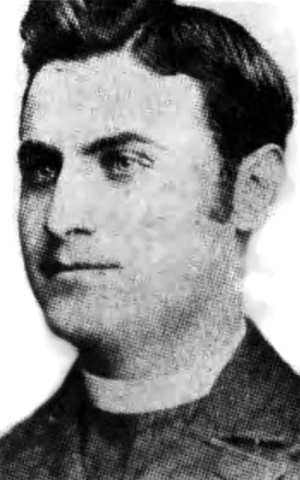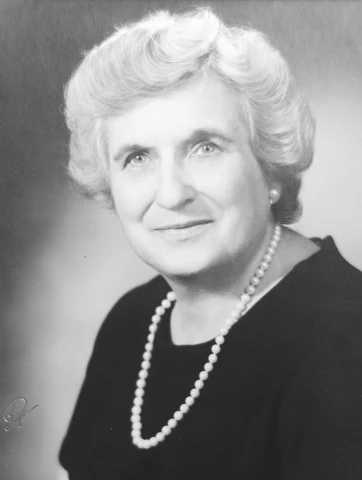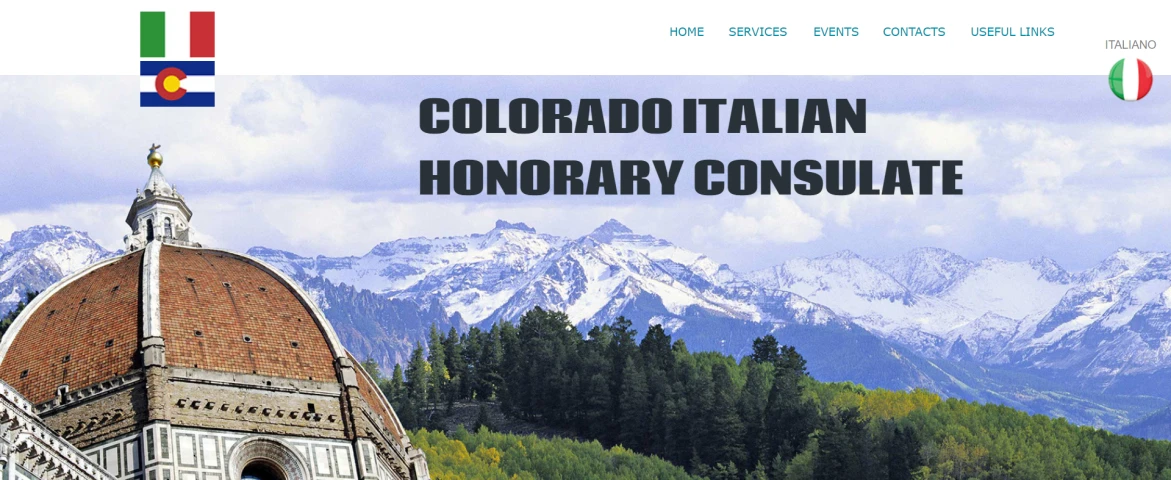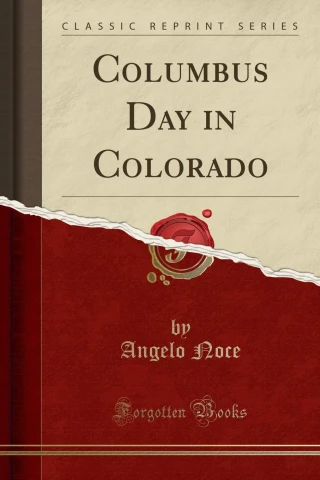Our tour of the United States takes us this time west to the Centennial State: Colorado. Here, too, there is a vibrant community that celebrates Italy, gathered around a successful magazine that for exactly 10 years has been led by a young Italian American, Jenna Capra.
We thank her three times: because with the magazine she directs, Andiamo! she tells about Italy with pride and pleasure; because she accepted to be the Ambassador of We the Italians; and because she is the guest of our interview. Thank you Jenna, welcome aboard!
Jenna, you are the Owner, Editor, & Publisher of Andiamo! - Colorado's Italian Community Newspaper. The magazine was founded in 2003, and you took over in 2011. So first of all, Happy Anniversary! Please tell us more about Andiamo!
Mille Grazie! It’s been a wonderful ten years and I’m so proud of our publication!
In short, Andiamo! is the Italian Community Newspaper for the state of Colorado and serves as a celebration of all things Italian. Our mission is to represent our culture and community in a positive way, while also sharing and preserving our histories. Published monthly (in English), each issue serves as a unifying source of news, information, and entertainment for all to enjoy.
Our articles cover everything from personal interviews with great Italian individuals, families, businesses, and organizations; to more general, informative articles regarding larger Italian and Italian American traditions, histories, and culture. The stories range from local to international, past to present, and touch on every topic imaginable—we’ve done everything from Amaretto to Zambelli and are always discovering more to feature in future issues (fortunately Italians have a lot of history and pride to pull from!)
In addition, we have a great arrangement with History Colorado (located in Denver) and the Colorado Italian American Preservation Association (CIAPA) that allows us to print photos from their historical archives for our “Page in Time” feature; along with a more in-depth, “Community Story” from Colorado history as well. And if that wasn’t enough, we also have rotating features that invite readers to get involved - recipes, book reviews, fun trivia lessons… and sometimes even our very own “cruciverba” (crossword puzzle) to solve!
Ultimately, Andiamo!” means “Let’s Go!” in Italian, and we use that positive, unifying idea to inspire and move us forward with each and every issue we put into print.
What’s the story of your family and its immigration to the US?
My family’s immigration story is actually fairly recent as my father, Salvatore Capra, immigrated to the United States in 1966 when he was 9 years old, with his parents, Guerino and Adelia, and older sister, Dora. They came from San Polo Matese - a small mountain town in the region of Molise - in search of a better life. Like so many before them, they saw America as the “land of milk and honey,” and made the difficult choice to leave everything and everyone they knew behind for the great promise of American opportunity.
Originally, it was my Nonna, Adelia’s idea. Her father, Nicola, had immigrated to Colorado in 1952, and she’d watched her mother, Filomena, and five siblings gradually follow him over. My Nonno, Guerino, however was understandably reluctant to leave Italy as the small farm they owned in San Polo was just becoming prosperous after years of hard work, and his side of the family still lived in Molise. But the possibility of a better life for his children in America ultimately swayed him.
In 1962, they entered the lottery system which dictated immigration quotas to the U.S. at the time, but had to wait four long years until the system was reformed under President Lyndon B. Johnson to finally pack their bags. With all their belongings stuffed into two large trunks, they boarded an ocean liner which took them across the Atlantic in April 1966; then finished the journey by train and bus to Denver, Colorado where relatives were waiting.
There, they shared a crowded three story house with family in north Denver’s “Little Italy” area, but had a hard time adapting to life in America as they didn’t know English and the language barrier was extremely difficult. Work also proved to be incredibly scarce and for a long time it didn’t seem like they would be able to stay - my Nonno actually wouldn’t let the family unpack their trunks for nearly three years until he had secured steady employment as a metalworker and felt confident enough that the Capras could finally consider Colorado their permanent home.
Even though their journey occurred well beyond the early days of Ellis Island, the sacrifices they made and the hardships they encountered were just as difficult, and their successes are a true testament to the Italian experience in the United States. As part of the first generation of my Italian American family born here, their story has always been a source of inspiration and pride for me, which is what originally led me to my work with Andiamo! and continues to drive me today...
What is the easiest and the hardest part in being editor of an Italian magazine in the US?
I think just being in the editorial industry at all is incredibly challenging these days. The nature of the business means there’s always an ominous deadline looming, but always a lot of uncertainty and pieces moving around until the last minute. Its stressful work and it can be easy to feel stretched too thin as there’s so much to keep track of and do!
However, the easiest part would definitely be researching and exploring the content we cover: Italy has given so much to the world and it’s always fascinating to dive into each topic and learn a little more than before... Often we start with one idea, which leads to another and another and another! It’s a lot of fun following the story threads we find, and the people we meet along the way are always wonderful as well. It’s a pleasure to be able interview them and share their stories in our pages.
Let’s talk about Italians in Colorado. Who were the first ones to arrive? What part of Italy were they from, and what did they do in Colorado?
Italians began to come to Colorado in the late 1850s, largely drawn by the mills, mines, and railroads of the time. Many toiled away in these incredibly hard and dangerous jobs until they had enough money to bring their families over and purchase their own land for farming or start small businesses. They mostly settled down in Denver, Trinidad, and Pueblo - all cities which still enjoy a strong Italian presence today, though there are pockets of Italian communities found all over the state. As was common in history, the majority of Italians that immigrated here initially came from the Mezzogiorno regions where conditions were poorest (families from Basilicata, Abruzzo, Molise, Calabria, and Sicily are very common here) but we do have some northern Italian representation as well (particularly from Trento).
One of the most interesting things I’ve heard across the many stories we’ve covered in Andiamo! is how the Rocky Mountains held special appeal to the immigrants who came here from similarly mountainous regions of Italy… Colorado’s beautiful landscapes reminded them a little bit of the homes they had left behind.
You see this in other places around the country as well, where immigrants from Italy’s coastal areas tended to stick closer to cities on American shores where they could put their skills and knowledge of the sea to good use fishing and sailing and the like. So it makes sense that many of the Italians who came here had extensive knowledge of mountain terrain, plains, and farming on some level.
Is there a place that is important to the Italian community in Colorado, or has been in the past? A Little Italy, a church, a park, a monument?
There are many, many important spots around the state, but the “Little Italy” area of Denver that my family once belonged to was historically located in Denver’s “North Side” neighborhoods. Around the 19th century, when Italians had earned enough to move out of the mining and railroad colonies and into better areas, they gravitated to the northwest side of Denver where they lived, struggled, and eventually thrived together; up through the 1960s and 70s when they began spreading out into the suburbs and beyond... During its prime though, Denver’s “Little Italy” was filled with popular Italian-owned restaurants, grocers, service shops, and other small businesses.
At the center of it all was Our Lady of Mount Carmel Catholic Church, built and paid for by the Italians at the time who scraped together the resources to provide a much-needed place for the community to worship in their own language and ways. Now, over 125 years later, the church remains an important cornerstone of the community and Colorado Italians continue to celebrate their baptisms, weddings, and other religious functions there.
The church also still serves as an important unifier for the community with beloved, annual, cultural traditions like the St. Joseph’s Table in March, and the Mt. Carmel Procession & Bazaar in July, which bring Italians back from every corner of the state to celebrate in full force each year. On the first Sunday of every month, there is also a dedicated “Prima Domenica” mass spoken in Italian, followed by a cultural reception and breakfast hosted by the community to gather and enjoy together.
Is there a name that in the past or today is worth remembering, because of what it has done for the Italian community in Colorado?
Several Italian names often get repeated (for good reason!) for their contributions to Colorado history. There’s Mother Francis Cabrini for the work she did in Colorado to help Italian immigrants and orphan children before she became the first American to be canonized as a Saint. There’s Angelo Noce, for his efforts to raise Italian profiles in society with the first Italian newspaper in Colorado (La Stella) and his work to establish Columbus Day as a holiday. There’s Father Mariano Lepore who helped lead the Italian community in the historic creation of Our Lady of Mount Carmel Church in Denver. There’s Genevieve D’Amato Fiore who organized an UNESCO chapter for world peace in Colorado and championed women and human rights all her life...
But one of the things I have always tried to emphasize with Andiamo! is the importance of “small stories” as well. That mission is part of what drew me to work in this field in the first place—the ability to shine the spotlight on the people and businesses that might not otherwise get to see it. There are so many names and stories that go unrecognized and untold in society, but have made such an incredible impact on their families and communities for the better: farmers, grocers, laborers, barbers, teachers, nurses, humanitarians, artists, mothers, fathers, and everything in between... People that may not have had the wealth or education or influence or opportunities to make the history books, yet still influenced our lives in powerful and positive ways.
We don’t always realize how significant the “everyday” person’s contributions can be or how strongly they’ve shaped our communities until we sit down and research them. It’s truly amazing how much we discover sometimes and I regularly encourage Andiamo! readers to reach out and interview their loved ones whenever they can. It’s so important that we remember to document our own personal histories so we can continue to celebrate and honor their names as well!
How is the Italian community in Colorado today? Are there many Italians? Is there an official consulate? Is there Made in Italy?
People are often surprised to discover Colorado’s Italian population is as prevalent as it is, but we’re definitely here! According to numbers provided by History Colorado, there are over 200,000 Italian Americans in Colorado (about 5% of the state’s population.) As the generations have grown and expanded away from the historical “Little Italy” areas, we’ve become a bit scattered, but the Italian community of Colorado is still very much “out there” and thriving in their own ways while still remaining connected through our shared passions and traditions.
The community turns out most visibly for the annual feasts and festivals around the state. We also have a variety of fantastic Italian organizations that serve all kinds of interests year-round, everything from the traditional fraternal organizations and mutual aid societies; to groups focused on providing community service and scholarships; groups for business networking; groups devoted to Italian education and language; groups for assisting with Italian genealogy research; groups formed simply for socializing together; recreational bocce leagues; and even a Morra league!
As for a consulate, Colorado Italians fall under the jurisdiction of the consulate in Chicago. We do have an honorary consulate however, who can still help our community members with limited hours and services, but it would be wonderful if we could get an official consulate in Denver to better serve the entire area.
Colorado was the very first state to approve a Columbus Day, in 1907, 37 years before President Franklin Roosevelt made it a federal holiday, but last year renamed it Cabrini Day, in honor of St. Frances Cabrini. The city of Denver, where in 1873 opened a bar called Christopher Columbus Hall, where every 12th of October there was a big party, also renamed Columbus Day as Indigenous People's Day. In Pueblo, there is a dispute that has been going on for months, some would like to remove the Columbus statue, others would like to keep it. What’s your idea about this?
This is a difficult and delicate subject; especially in Colorado where, as you noted, there is so much additional history surrounding the holiday. People feel very strongly no matter where they fall on the issue and the controversies that have grown around it are complex and emotionally charged.
I believe it’s important to recognize history, and it’s also important to be critical: but the narratives have become irreparably twisted and I honestly don’t know what the solution is. From where I stand, the holiday was always symbolic for our communities: Columbus was chosen because he was one of the few Italian names Americans actually knew and respected at the time, but ultimately it was about establishing a day to honor the incredible bravery, hardships, and sacrifices of our ancestors, and the great contributions Italian Americans have made to this country ever since.
I think it’s a shame to see Italians getting shortchanged in that regard now: they still deserve to celebrate their holiday by whatever name, and the dispute over what name (despite how important that discussion may be) seems to have lost sight of that fact in the noise. I’m always hesitant to speak on the subject because of how complex it clearly is, but I’m hopeful Italians will still be able to happily honor their heritage alongside the larger community and think it’s notable October has become Italian Heritage Month in America as a whole, something that probably deserves a lot more promotion and celebration from our communities as well!
Il nostro giro degli Stati Uniti ci porta stavolta a ovest, nel Centennial State: il Colorado. Anche qui c'è una vivace comunità che celebra l'Italia, raccolta attorno ad un magazine di successo che da 10 anni esatti è guidato da una giovane italoamericana, Jenna Capra.
La ringraziamo tre volte: perché con il magazine che dirige, Andiamo! racconta l'Italia con orgoglio e piacere; perché ha accettato di essere la Ambassador di We the Italians; e perché è l'ospite della nostra intervista. Grazie Jenna, welcome aboard!
Jenna, tu sei la proprietaria, redattrice ed editrice di Andiamo! - il giornale della comunità italiana del Colorado. Il magazine è stato fondato nel 2003, e tu sei subentrata nel 2011. Quindi, prima di tutto, buon anniversario! Per favore, ci dica di più su Andiamo!
Mille Grazie! Sono stati dieci anni meravigliosi e sono molto orgogliosa della nostra pubblicazione!
In breve, Andiamo! è il giornale della comunità italiana per lo stato del Colorado e celebra tutto ciò che è italiano. La nostra missione è quella di rappresentare la nostra cultura e la nostra comunità in modo positivo, condividendo e preservando le nostre storie. Pubblicato mensilmente (in inglese), ogni numero è una fonte di notizie, informazioni e intrattenimento per tutti.
I nostri articoli coprono tutto, dalle interviste personali con grandi individui, famiglie, imprese e organizzazioni italiane, ad articoli più generali e informativi riguardanti le tradizioni, la storia e la cultura italiana e italoamericana. Le storie spaziano dal locale all'internazionale, dal passato al presente, e toccano ogni argomento immaginabile - abbiamo raccontato di tutto, dall'Amaretto a Zambelli e ogni volta scopriamo altro da presentare nei numeri futuri. Fortunatamente gli italiani hanno un sacco di storia e orgoglio da cui attingere!
Inoltre, abbiamo un ottimo accordo con History Colorado (con sede a Denver) e la Colorado Italian American Preservation Association (CIAPA) che ci permette di stampare foto dai loro archivi storici per la nostra rubrica "Page in Time"; insieme a una più approfondita "Community Story" dalla storia del Colorado. E se questo non bastasse, abbiamo anche spazi che invitano i lettori a essere coinvolti - ricette, recensioni di libri, divertenti lezioni di trivia... e talvolta anche il nostro cruciverba da risolvere!
In definitiva, visto il significato della parola “Andiamo”, usiamo questa idea positiva per ispirarci e farci andare avanti con ogni numero che mettiamo in stampa.
Qual è la storia della tua famiglia e della sua immigrazione negli Stati Uniti?
La storia dell'immigrazione della mia famiglia è in realtà abbastanza recente: mio padre, Salvatore Capra, è emigrato negli Stati Uniti nel 1966, quando aveva 9 anni, con i suoi genitori, Guerino e Adelia, e la sorella maggiore, Dora. Partirono da San Polo Matese - un piccolo paese di montagna nella regione del Molise - in cerca di una vita migliore. Come molti prima di loro, videro l'America come la "terra del latte e del miele" e fecero la difficile scelta di lasciare tutto e tutti quelli che conoscevano per la grande promessa delle opportunità americane.
In origine, fu un'idea di mia nonna Adelia. Suo padre, Nicola, era emigrato in Colorado nel 1952, e lei aveva visto sua madre, Filomena, e cinque fratelli seguirlo gradualmente. Mio nonno, Guerino, tuttavia, era comprensibilmente riluttante a lasciare l'Italia, dato che la piccola fattoria che possedevano a San Polo stava appena diventando prospera dopo anni di duro lavoro, e la sua parte della famiglia viveva ancora in Molise. Ma la possibilità di una vita migliore per i suoi figli in America alla fine lo fece cambiare idea.
Nel 1962, entrarono nel sistema di lotteria che all'epoca dettava le quote di immigrazione negli Stati Uniti, ma dovettero aspettare quattro lunghi anni finché il sistema fu riformato sotto il presidente Lyndon B. Johnson per fare finalmente le valigie. Con tutti i loro averi stipati in due grandi bauli, si imbarcarono su un transatlantico che li portò attraverso l'Atlantico nell'aprile 1966; poi finirono il viaggio in treno e autobus fino a Denver, Colorado, dove li aspettavano i parenti.
Lì, condivisero un'affollata casa di tre piani con la famiglia nella zona nord di Denver, "Little Italy", ma ebbero difficoltà ad adattarsi alla vita in America perché non conoscevano l'inglese e la barriera linguistica era estremamente difficile. Anche il lavoro si dimostrò incredibilmente scarso e per molto tempo non sembrava che sarebbero stati in grado di rimanere - mio nonno non permise alla famiglia di disfare i bagagli per quasi tre anni fino a quando non si assicurò un lavoro stabile come operaio metallurgico e si sentì abbastanza sicuro che i Capra potessero finalmente considerare il Colorado la loro casa permanente.
Anche se il loro viaggio è avvenuto ben oltre i primi giorni di Ellis Island, i sacrifici che hanno fatto e le difficoltà che hanno incontrato sono state altrettanto difficili, e i loro successi sono una vera testimonianza dell'esperienza italiana negli Stati Uniti. Come parte della prima generazione della mia famiglia italoamericana nata qui, la loro storia è sempre stata una fonte di ispirazione e di orgoglio per me, che è ciò che originariamente mi ha portato al mio lavoro con Andiamo! e continua a guidarmi oggi...
Qual è la parte più facile e quella più difficile nell'essere editore di una rivista italiana negli Stati Uniti?
Penso che il solo fatto di essere nell'industria editoriale sia incredibilmente impegnativo di questi tempi. La natura del business significa che c'è sempre una scadenza che incombe, ma anche molta incertezza e pezzi che si spostano fino all'ultimo minuto. È un lavoro stressante e può essere facile sentirsi in difficoltà perché c'è così tanto da tenere sotto controllo e da fare!
Tuttavia, la parte più facile è sicuramente la ricerca e l'esplorazione dei contenuti che copriamo: l'Italia ha dato così tanto al mondo ed è sempre affascinante immergersi in ogni argomento e imparare un po' di più di prima... Spesso iniziamo con un'idea, che porta a un'altra e un'altra e un'altra ancora! È molto divertente seguire i fili della storia che troviamo, e anche le persone che incontriamo lungo la strada sono sempre meravigliose. È un piacere poterli intervistare e condividere le loro storie nelle nostre pagine.
Parliamo degli italiani in Colorado. Chi furono i primi ad arrivare? Da quale parte d'Italia venivano e perché arrivarono in Colorado?
Gli italiani cominciarono a venire in Colorado alla fine del 1850, in gran parte attratti dai mulini, dalle miniere e dalle ferrovie dell'epoca. Molti lavorarono duramente in questi lavori incredibilmente difficili e pericolosi fino a quando ebbero abbastanza soldi per portare qui le loro famiglie e acquistare la loro terra per coltivare frutta e verdura o avviare piccole imprese. Si stabilirono soprattutto a Denver, Trinidad e Pueblo - tutte città che ancora oggi godono di una forte presenza italiana, anche se ci sono sacche di comunità italiane in tutto lo stato. Come tratto comune nella storia, la maggior parte degli italiani immigrati qui inizialmente proveniva dalle regioni del Mezzogiorno, dove le condizioni erano più povere (famiglie dalla Basilicata, Abruzzo, Molise, Calabria e Sicilia sono molto comuni qui), ma abbiamo anche qualche rappresentanza italiana del nord (in particolare da Trento).
Una delle cose più interessanti che ho sentito nelle molte storie che abbiamo raccontato è come le Montagne Rocciose abbiano avuto un fascino speciale per gli immigrati che sono venuti qui da regioni montuose simili dell'Italia... i bei paesaggi del Colorado ricordavano loro un po' le zone che avevano lasciato.
Lo si vede anche in altri luoghi del paese, dove gli immigrati dalle zone costiere italiane tendevano a rimanere più vicini alle città sulle coste americane dove potevano mettere le loro abilità e conoscenze del mare a buon uso pescando e navigando. Quindi ha senso che molti degli italiani che sono venuti qui avessero una vasta conoscenza delle montagne, delle pianure e delle zone agricole italiane.
C'è un luogo che è importante per la comunità italiana in Colorado, o lo è stato in passato? Una Little Italy, una chiesa, un parco, un monumento?
Ci sono molti, molti luoghi importanti in tutto lo stato, ma la zona di "Little Italy" di Denver a cui la mia famiglia apparteneva una volta era storicamente situata nei quartieri del "North Side" di Denver. Intorno al XIX secolo, quando gli italiani avevano guadagnato abbastanza per spostarsi dalle colonie minerarie e ferroviarie in zone migliori, gravitavano sul lato nord-ovest di Denver dove vissero con molti sacrifici e alla fine prosperarono insieme fino agli anni '60 e '70 quando iniziarono a spostarsi nei sobborghi e oltre... Durante il suo periodo di massimo splendore, la "Little Italy" di Denver era piena di popolari ristoranti, drogherie, negozi di servizi e altre piccole imprese di proprietà italiana.
Al centro di tutto questo c'era la chiesa cattolica di Our Lady of Mount Carmel, costruita e pagata dagli italiani di allora, che misero insieme le risorse per fornire alla comunità un luogo di culto della loro religione che li accogliesse nella loro lingua, di cui avevano tanto bisogno. Ora, più di 125 anni dopo, la chiesa rimane un'importante pietra miliare della comunità e gli italiani del Colorado continuano a celebrarvi i loro battesimi, matrimoni e altre funzioni religiose.
La chiesa serve anche come importante unificatore per la comunità con tradizioni culturali annuali molto amate come la Tavola di San Giuseppe a marzo e la Processione e la festa del Mount Carmel a luglio, che vedono arrivare italiani da ogni angolo del Colorado per festeggiare secondo le loro tradizioni ogni anno. La prima domenica di ogni mese, c'è anche "Prima Domenica", una messa dedicata parlata in italiano, seguita da un ricevimento culturale e una colazione ospitata dalla comunità per riunirsi e divertirsi insieme.
C'è un nome che in passato o oggi vale la pena ricordare, per quello che ha fatto per la comunità italiana in Colorado?
Diversi nomi italiani vengono spesso ripetuti (a ragione!) per i loro contributi alla storia del Colorado. C'è Madre Francis Cabrini per il lavoro che ha fatto in Colorado per aiutare gli immigrati italiani e i bambini orfani prima di diventare la prima americana ad essere canonizzata come santa. C'è Angelo Noce, per i suoi sforzi per elevare i profili italiani nella società con il primo giornale italiano in Colorado (La Stella) e il suo lavoro per stabilire il Columbus Day come festa. C'è Padre Mariano Lepore che ha aiutato a guidare la comunità italiana nella storica creazione della Chiesa di Our Lady of Mount Carmel a Denver. C'è Genevieve D'Amato Fiore che ha organizzato un club dell'UNESCO per la pace nel mondo in Colorado e ha sostenuto le donne e i diritti umani per tutta la sua vita...
Ma una delle cose che ho sempre cercato di sottolineare con Andiamo! è l'importanza delle "piccole storie". Questo obiettivo è parte di ciò che mi ha spinto a lavorare in questo campo in primo luogo - la capacità di puntare i riflettori sulle persone e le imprese che altrimenti non potrebbero essere conosciuti. Ci sono così tanti nomi e storie che non vengono riconosciuti e raccontati nella società, ma che hanno avuto un impatto incredibilmente positivo sulle loro famiglie e comunità: agricoltori, droghieri, operai, barbieri, insegnanti, infermieri, umanitari, artisti, madri, padri, e tutto il resto... Persone che possono non aver avuto la ricchezza o l'educazione o l'influenza o le opportunità per entrare nei libri di storia, ma che hanno comunque influenzato le nostre vite in modi importanti e positivi.
Non sempre ci rendiamo conto di quanto possano essere significativi i contributi delle persone "comuni" o di quanto fortemente abbiano plasmato le nostre comunità finché non ci sediamo e facciamo ricerca. È davvero sorprendente quante cose scopriamo a volte e io incoraggio regolarmente i lettori di Andiamo! a raggiungere e intervistare i loro cari ogni volta che possono. È così importante che ci ricordiamo di documentare le nostre storie personali in modo da poter continuare a celebrare e onorare anche i loro nomi!
Com'è la comunità italiana in Colorado oggi? Ci sono molti italiani? C'è un consolato ufficiale? C'è il Made in Italy?
Le persone sono spesso sorprese di scoprire che la popolazione italiana del Colorado è così numerosa, ma sicuramente ci siamo! Secondo i numeri forniti da History Colorado, ci sono oltre 200.000 italoamericani in Colorado (circa il 5% della popolazione dello Stato). Con la crescita e l'espansione delle generazioni lontano dalle aree storiche di "Little Italy", siamo diventati un po' più sparpagliati, ma la comunità italiana del Colorado è ancora molto "là fuori" e prospera a modo suo, rimanendo collegata attraverso le nostre passioni e tradizioni comuni.
La comunità si manifesta più visibilmente per le feste e i festival annuali in tutto lo Stato. Abbiamo anche una varietà di fantastiche organizzazioni italiane che servono tutti i tipi di interessi durante tutto l'anno: dalle tradizionali organizzazioni fraterne e società di mutuo soccorso a gruppi focalizzati sul fornire servizi alla comunità e borse di studio; dai gruppi per il business networking a quelli dedicati all'educazione e alla lingua italiana; da chi assiste nella ricerca genealogica italiana a chi è nato semplicemente per socializzare insieme; e ancora squadre di giocatori di bocce e persino una lega di persone che si riuniscono per giocare a Morra!
Per quanto riguarda il Consolato, gli italiani del Colorado sono sotto la giurisdizione del Consolato di Chicago. Abbiamo comunque un Consolato Onorario, che può aiutare i membri della nostra comunità con orari e servizi limitati, ma sarebbe meraviglioso se potessimo avere un Consolato ufficiale a Denver per servire meglio l'intera area.
Il Colorado fu il primo Stato ad approvare un Columbus Day, nel 1907, 37 anni prima che il presidente Franklin Roosevelt lo rendesse una festa federale, ma l'anno scorso lo ha rinominato Cabrini Day, in onore di Santa Francesca Cabrini. Anche la città di Denver, dove nel 1873 aprì un bar chiamato Christopher Columbus Hall, dove ogni 12 ottobre c'era una grande festa, ha rinominato il Columbus Day come Indigenous People's Day. A Pueblo, c'è una disputa che va avanti da mesi, alcuni vorrebbero rimuovere la statua di Colombo, altri vorrebbero tenerla. Qual è la tua idea in merito?
Questo è un argomento difficile e delicato; specialmente in Colorado dove, come hai descritto, c'è così tanta storia che circonda la festa. Su questa questione le persone hanno un’opinione molto forte, a prescindere da quale sia la loro posizione, e le controversie che sono cresciute intorno ad essa sono complesse ed emotivamente cariche.
Credo che sia importante riconoscere la storia, ed è anche importante essere critici: ma le narrazioni sono diventate irrimediabilmente contorte e onestamente non so quale sia la soluzione. Dal mio punto di vista, la festa è sempre stata simbolica per le nostre comunità: Colombo fu scelto perché era uno dei pochi nomi italiani che gli americani conoscevano e rispettavano all'epoca, ma in definitiva si trattava di stabilire un giorno per onorare l'incredibile coraggio, le difficoltà e i sacrifici dei nostri antenati, e i grandi contributi che gli italoamericani hanno dato a questo Paese da allora.
Penso che sia una vergogna vedere che gli italiani vengano sminuiti in questo senso ora: meritano ancora di celebrare la loro festa con qualsiasi nome, e la disputa su quale nome (nonostante quanto importante possa essere quella discussione) sembra aver perso di vista questo fatto. Sono sempre riluttante a parlare dell'argomento a causa di quanto sia chiaramente complesso, ma spero che gli Italiani saranno ancora in grado di onorare felicemente il loro patrimonio culturale e penso che sia notevole che ottobre sia diventato il mese del patrimonio culturale italiano in America nel suo complesso, qualcosa che probabilmente merita molta più promozione e celebrazione anche da parte delle nostre comunità!


